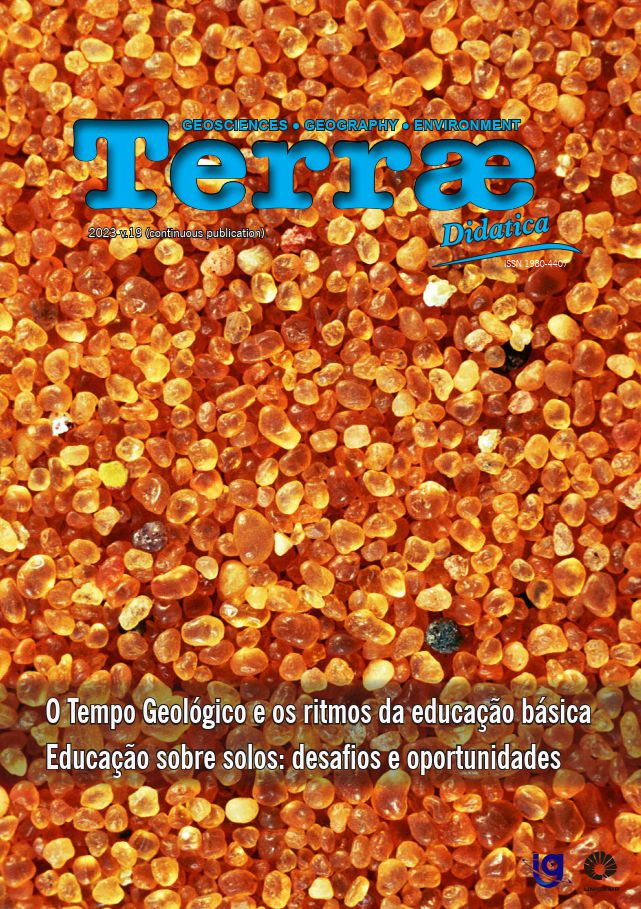Abstract
Introduction and Objective. This essay presents a review of the article Geological fakes and frauds by Ruffel, Majury & Brooks, published in Earth-Science Reviews in 2012 (doi: 10.1016/j.earscirev.2011.12.001). Methodology. The article addresses recurrent frauds and falsifications throughout the history of Geology, dividing them into three groups: (a) economic aspects, such as substitution and falsification of gems and precious stones, mining, and gas and oil extraction; (b) aesthetic and academic reasons, mainly in Paleontology; and (c) historical and archaeological events. The main motivations behind these practices are financial gain, aesthetic appeal, and academic development. Results. Such practices are not recent, and they bring important reflections on the role of Geology in revealing frauds. Both Popper's principle of falsifiability and the scientific method are essential in understanding how sciences deal with such situations. In particular, the geological studies used in detecting frauds confer even greater credibility to Geology as a scientific field. Conclusion. We hope to be possible to adopt a stance of 'healthy cynicism' regarding scientific reports, to better understand the establishment of Geology as a science, and to identify suspicious and criminal situations in the geological sciences.
References
Acharya, A. (2009). Targeting Terrorist Financing: international cooperation and new regimes. Abingdon: Routledge. 241p.
Bernard, E. (2022). Exploring authenticity through classical art: originals, fakes and copies. Studies in Conservation, 67(1-2), 38-49. doi: 10.1080/00393630.2021.1970461.
Boles, J.D. (2008). Diamond detail and gem fraud status. Journal of Financial Regulation and Compliance, 16(1), 77-84. doi: 10.1108/13581980810853226.
Cole, J. R., & Godfrey, L. R. (1985). The Paluxy River footprint mystery -- solved. Creation/Evolution, 5(1). URL: https://eric.ed.gov/?id=ED265059. Acesso 21.02.2023.
Corbacho, J., & Sendino, C. (2012). Fossil fakes and their recognition. Deposits Magazine, 30, 35-40. URL: https://www.academia.edu/download/46505458/Fossil_fakes_and_their_recognition20160615-3420-k1ab35.pdf. Acesso 21.02.2023.
Dalton, R. (2000). Chasing the dragons. Nature, 406, 930-933. doi: 10.1038/35023182.
Darlington, J. (2020). Fake heritage: why we rebuild monuments. New Haven: Yale University Press. 248p.
Depalma, A. (1997). At end of a miner's rainbow, a cloud of confusion lingers. The New York Times, D1. URL: https://www.nytimes.com/1997/03/31/business/at-end-of-a-miner-s-rainbow-a-cloud-of-confusion-lingers.html. Acesso 21.02.2023.
Donnelly, L. J., & Ruffell, A. (2021). Emerging applications of forensic geology. In: Donnelly, L. J., Pirrie, D., Harrison, M., Ruffell, A. & Dawson, L. (Eds.). (2021). A Guide to Forensic Geology. London: The Geological Society. pp. 171-187.
Grimaldi, D. A., Shedrinsky, A., Ross, A., & Baer, N. S. (1994). Forgeries of fossils in “amber”: history, identification and case studies. Curator: The Museum Journal, 37(4), 251-274. doi: 10.1111/j.2151-6952.1994.tb01023.x.
Heinrich, P. V. (2007). Pseudoscience in Bosnia. Science, 318(5847), 42-43. doi: 10.1126/science.318.5847.42c.
Kuban, G. J. (1989). A matter of degree: an examination of Carl Baugh's alleged credentials. NCSE Reports, 9(6).
Le Billon, P. (2001). The political ecology of war: natural resources and armed conflicts. Political Geography, 20(5), 561-584. doi: 10.1016/S0962-6298(01)00015-4.
Le Billon, P. (2004). The geopolitical economy of ‘resource wars’. Geopolitics, 9(1), 1-28. doi: 10.1080/14650040412331307812.
Marcos, A. (2018). ¿Puede evitarse el fraude en ciencia? Investigación y Ciencia, 498, 44-45.
McBirney, A., & Janvier, P. (2005). The Trilobite Affair. English translation of H. Wild's Les Chiens Aboient, with annotations by the translators. Eugene: Bostok Press. 350p.
Murray, R. C. (2004). Evidence from the earth: forensic geology and criminal investigation. Missoula: Mountain Press Publishing. 240p.
Nicholls, C. C. (1999). The Bre-X hoax: a South East Asian bubble. The Canadian Business Law Journal, 32(2), 173-192.
Oakley, K. P., & Groves, C. P. (1970). Piltdown man: the realization of fraudulence. Science, 169(3947), 789. doi: 10.1126/science.169.3947.789.
Oliveira, A. F. M., & Oliveira, S. M. P. (2023). Fake news e divulgação científica: um estudo sobre o caso Atila Iamarino. Revista Docência e Cibercultura, 7(2), 141-163. doi: 10.12957/redoc.2023.67918.
Pain, S. (2004). Histories: Johann Beringer and the fraudulent fossils. New Scientist, 184(2479-2480), 74-75. URL: https://www.newscientist.com/article/mg18424793-300-histories-johann-beringer-and-the-fraudulent-fossils/. Acesso 21.02.2023.
Peluso, N. L., & Watts, M. (Eds.). (2001). Violent environments. Ithaca: Cornell University Press. 464p.
Popper, K. (1959). The Logic of Scientific Discovery. Abingdon: Routledge. 544p.
Popper, K. (1963). Conjectures and refutations: the growth of scientific knowledge. Abingdon: Routledge. 608p.
Romsom, E. (2022). Global oil theft: impact and policy responses. Helsinki: UNU-WIDER. WIDER Working Paper 2022/16. doi: 10.35188/UNU-WIDER/2022/147-1.
Ross, M. L. (2004). How do natural resources influence civil war? Evidence from thirteen cases. International Organization, 58(1), 35-67. doi: 10.1017/S002081830458102X.
Ruffell, A., Majury, N., & Brooks, W. E. (2012). Geological fakes and frauds. Earth-Science Reviews, 111(1-2), 224-231. doi: 10.1016/j.earscirev.2011.12.001.
Scientific American. (1856). Curious use of the microscope. Scientific American, 11(30), 240. URL: https://hdl.handle.net/2027/coo.31924080787611. Acesso 21.02.2023.
Veronesi, C. (2014). Falsifications and scientific progress: Popper as sceptical optimist. Lettera Matematica, 1(4), 179-184. doi: 10.1007/s40329-014-0031-7.
Washburn, S. L. (1953). The Piltdown hoax. American Anthropologist, 55(5), 759-762. URL: https://www.jstor.org/stable/664751. Acesso 21.02.2023.
Watts, J. (2013, September 9). NSA accused of spying on Brazilian oil company Petrobras. The Guardian, World.
Wild, H. (1926). Les chiens aboient. Paris: Albin Michel. 366p.
Referências das figuras
Goodayle, L. (n.d.). Plesiosaurus no Museu de História Natural de Londres. Photograph. URL: https://www.theguardian.com/science/2019/mar/16/mary-anning-female-fossil-hunter-changed-science. Acesso 21.02.2023 .
Phony tiara fooled Louvre. (1955). Life Magazine, 39(13), 144.
St. John, J. (2007). Fake amethyst geode (Morocco). Photograph. URL: https://www.flickr.com/photos/jsjgeology/31769323994/ and licensed under the terms of CC BY 2.0. Acesso 21.02.2023.

This work is licensed under a Creative Commons Attribution-NonCommercial 4.0 International License.
Copyright (c) 2023 Terræ Didatica


